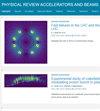Beam gas curtain monitor: Vacuum studies for LHC integration and operation
IF 1.5
3区 物理与天体物理
Q3 PHYSICS, NUCLEAR
Physical Review Accelerators and Beams
Pub Date : 2024-04-12
DOI:10.1103/physrevaccelbeams.27.043201
引用次数: 0
Abstract
A beam gas curtain (BGC) monitor has been designed to obtain information about the relative position between the LHC proton beam and the hollow electron lens electron beam through a minimally invasive process. Its working principle relies on intersecting the path of both beams with a supersonic gas curtain, introduced transversely into the LHC beamline, to produce a fluorescence signal. As an intermediate project stage (phase II), a preliminary version of the BGC monitor has been installed into the LHC beamline. To ensure the successful integration of the monitor and subsequent operation under LHC ultrahigh vacuum conditions, a series of vacuum studies have been performed. These can be classified as follows: An off-line laboratory test campaign, to assess BGC behavior during pump down and gas injections; simulations and analytical calculations, to evaluate BGC behavior and estimate the impact of its installation and operation in the LHC. This document will briefly present the off-line tests campaign, followed by a more extensive description of the simulations performed.

光束气幕监测器:用于大型强子对撞机集成和运行的真空研究
光束气帘(BGC)监测器的设计目的是通过微创过程获取关于大型强子对撞机质子束与空心电子透镜电子束之间相对位置的信息。其工作原理是将两束质子束的路径与横向引入大型强子对撞机光束线的超音速气幕相交,从而产生荧光信号。作为项目的中间阶段(第二阶段),BGC 监测器的初步版本已安装到大型强子对撞机光束线中。为确保监测器的成功集成以及随后在大型强子对撞机超高真空条件下的运行,进行了一系列真空研究。这些研究可分为以下几类:离线实验室测试活动,评估BGC在抽气和气体注入时的行为;模拟和分析计算,评估BGC的行为,并估计其安装和在大型强子对撞机中运行的影响。本文件将简要介绍离线测试活动,然后更广泛地介绍所进行的模拟。
本文章由计算机程序翻译,如有差异,请以英文原文为准。
求助全文
约1分钟内获得全文
求助全文
来源期刊

Physical Review Accelerators and Beams
Physics and Astronomy-Surfaces and Interfaces
CiteScore
3.90
自引率
23.50%
发文量
158
审稿时长
23 weeks
期刊介绍:
Physical Review Special Topics - Accelerators and Beams (PRST-AB) is a peer-reviewed, purely electronic journal, distributed without charge to readers and funded by sponsors from national and international laboratories and other partners. The articles are published by the American Physical Society under the terms of the Creative Commons Attribution 3.0 License.
It covers the full range of accelerator science and technology; subsystem and component technologies; beam dynamics; accelerator applications; and design, operation, and improvement of accelerators used in science and industry. This includes accelerators for high-energy and nuclear physics, synchrotron-radiation production, spallation neutron sources, medical therapy, and intense-beam applications.
 求助内容:
求助内容: 应助结果提醒方式:
应助结果提醒方式:


